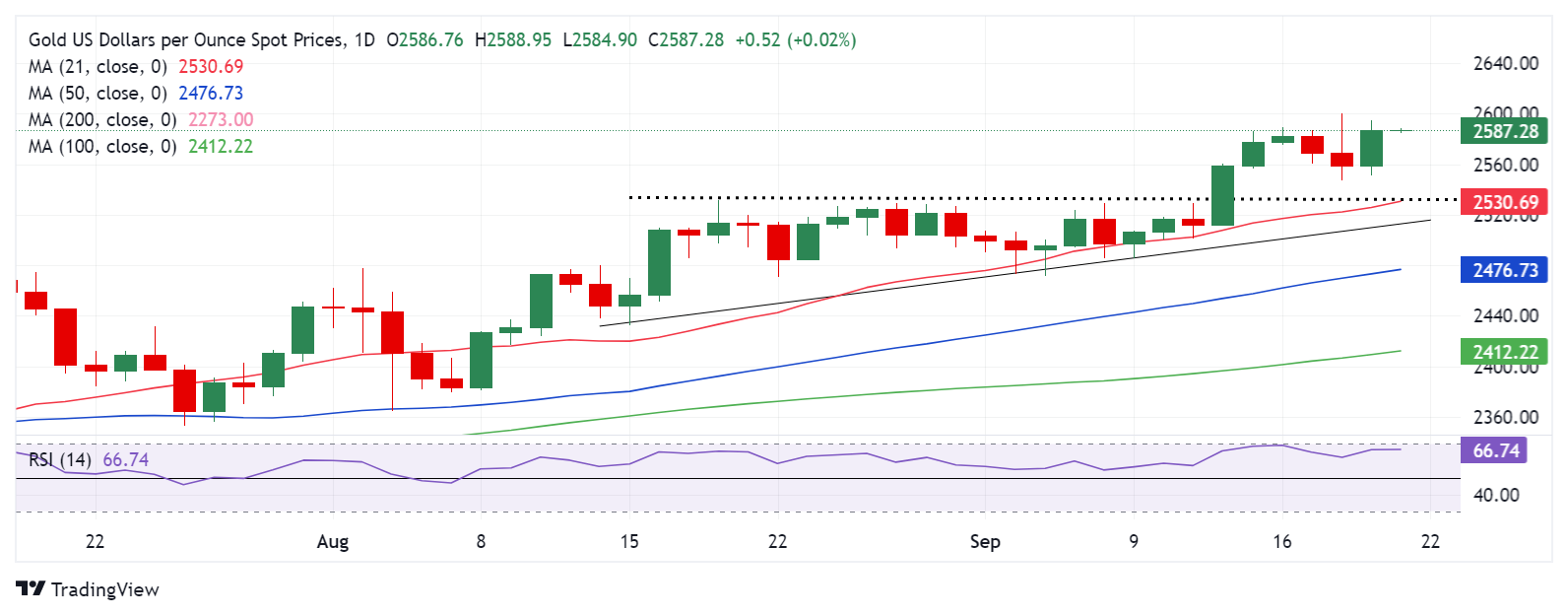Gold Price Forecast: XAU/USD consolidates weekly gains, with sight on $2,600 and beyond
Premium|
You have reached your limit of 5 free articles for this month.
Get all exclusive analysis, access our analysis and get Gold and signals alerts
Elevate your trading Journey.
UPGRADE- Gold price consolidates below record highs at $2,600 early Friday, as Fedsepak awaited.
- As traders digest the Fed's big rate cut, the US Dollar licks wounds with Treasury bond yields.
- Gold buyers stay hopeful amid the daily bullish RSI, as $2,600 resistance appears at risk.
Gold price is looking to build on the previous day’s rebound early Friday, consolidating weekly gains amid the overnight weakness in the US Dollar (USD) alongside the US Treasury bond yields. Traders now await the speeches from US Federal Reserve (Fed) monetary policymakers for fresh hints on the central bank’s path forward on interest rates.
Gold price takes a breather, with Fedspeak eyed
The USD has paused its recent downside, as markets turn risk-averse and buck the Wall Street rally after the People’s Bank of China (PBOC) disappointed by leaving the mortgage lending rate unchanged. Markets expected the Chinese central bank to cut the Loan Prime Rates (LPR) amid growing economic slowdown concerns.
A stabilizing US Dollar seems to caution Gold buyers but the downside remains cushioned amid increased haven demand for the traditional safety asset on China worries. They also remain wary and refrain from placing fresh bets, anticipating the Bank of Japan’s (BoJ) policy announcements.
Although the BoJ is widely expected to leave interest rates unchanged, any surprise could trigger the USD/JPY pair-led US Dollar volatility, eventually impacting the USD-denominated Gold price.
That said, Gold price could witness a brief correction, if traders resort to profit-taking due to the recent rally and ahead of next week’s US macro data and Fed Chair Jerome Powell’s appearance.
On Thursday, the bright metal staged a solid rebound toward the all-time high of $2,600 but fell slightly short of it amid the two-way swings seen in the US Dollar, as traders digested the dovish Fed outlook amid the return of risk appetite and mixed US Jobless Claims and Existing Home Sales data.
Gold price technical analysis: Daily chart
As observed on the daily chart, the Gold price outlook appears constructive in the short term as long as the crucial support at $2,532 is defended.
That level is the confluence of the August 20 high and the 21-day Simple Moving Average (SMA).
The 14-day Relative Strength Index (RSI) has turned flat while staying firm above the 50 level, currently near 66.50, adding credence to the bullish potential.
The record high at $2,600 will be challenged if Gold price regains the upside traction. Acceptance above that level will call for a test of the $2,650 psychological barrier.
On the downside, Gold sellers need to crack the $2,550 demand area for the correction to extend toward the abovementioned key support at $2,532.
A sustained break below that level will likely extend the decline toward the rising trendline support at $2,512.
Gold FAQs
Gold has played a key role in human’s history as it has been widely used as a store of value and medium of exchange. Currently, apart from its shine and usage for jewelry, the precious metal is widely seen as a safe-haven asset, meaning that it is considered a good investment during turbulent times. Gold is also widely seen as a hedge against inflation and against depreciating currencies as it doesn’t rely on any specific issuer or government.
Central banks are the biggest Gold holders. In their aim to support their currencies in turbulent times, central banks tend to diversify their reserves and buy Gold to improve the perceived strength of the economy and the currency. High Gold reserves can be a source of trust for a country’s solvency. Central banks added 1,136 tonnes of Gold worth around $70 billion to their reserves in 2022, according to data from the World Gold Council. This is the highest yearly purchase since records began. Central banks from emerging economies such as China, India and Turkey are quickly increasing their Gold reserves.
Gold has an inverse correlation with the US Dollar and US Treasuries, which are both major reserve and safe-haven assets. When the Dollar depreciates, Gold tends to rise, enabling investors and central banks to diversify their assets in turbulent times. Gold is also inversely correlated with risk assets. A rally in the stock market tends to weaken Gold price, while sell-offs in riskier markets tend to favor the precious metal.
The price can move due to a wide range of factors. Geopolitical instability or fears of a deep recession can quickly make Gold price escalate due to its safe-haven status. As a yield-less asset, Gold tends to rise with lower interest rates, while higher cost of money usually weighs down on the yellow metal. Still, most moves depend on how the US Dollar (USD) behaves as the asset is priced in dollars (XAU/USD). A strong Dollar tends to keep the price of Gold controlled, whereas a weaker Dollar is likely to push Gold prices up.
- Gold price consolidates below record highs at $2,600 early Friday, as Fedsepak awaited.
- As traders digest the Fed's big rate cut, the US Dollar licks wounds with Treasury bond yields.
- Gold buyers stay hopeful amid the daily bullish RSI, as $2,600 resistance appears at risk.
Gold price is looking to build on the previous day’s rebound early Friday, consolidating weekly gains amid the overnight weakness in the US Dollar (USD) alongside the US Treasury bond yields. Traders now await the speeches from US Federal Reserve (Fed) monetary policymakers for fresh hints on the central bank’s path forward on interest rates.
Gold price takes a breather, with Fedspeak eyed
The USD has paused its recent downside, as markets turn risk-averse and buck the Wall Street rally after the People’s Bank of China (PBOC) disappointed by leaving the mortgage lending rate unchanged. Markets expected the Chinese central bank to cut the Loan Prime Rates (LPR) amid growing economic slowdown concerns.
A stabilizing US Dollar seems to caution Gold buyers but the downside remains cushioned amid increased haven demand for the traditional safety asset on China worries. They also remain wary and refrain from placing fresh bets, anticipating the Bank of Japan’s (BoJ) policy announcements.
Although the BoJ is widely expected to leave interest rates unchanged, any surprise could trigger the USD/JPY pair-led US Dollar volatility, eventually impacting the USD-denominated Gold price.
That said, Gold price could witness a brief correction, if traders resort to profit-taking due to the recent rally and ahead of next week’s US macro data and Fed Chair Jerome Powell’s appearance.
On Thursday, the bright metal staged a solid rebound toward the all-time high of $2,600 but fell slightly short of it amid the two-way swings seen in the US Dollar, as traders digested the dovish Fed outlook amid the return of risk appetite and mixed US Jobless Claims and Existing Home Sales data.
Gold price technical analysis: Daily chart
As observed on the daily chart, the Gold price outlook appears constructive in the short term as long as the crucial support at $2,532 is defended.
That level is the confluence of the August 20 high and the 21-day Simple Moving Average (SMA).
The 14-day Relative Strength Index (RSI) has turned flat while staying firm above the 50 level, currently near 66.50, adding credence to the bullish potential.
The record high at $2,600 will be challenged if Gold price regains the upside traction. Acceptance above that level will call for a test of the $2,650 psychological barrier.
On the downside, Gold sellers need to crack the $2,550 demand area for the correction to extend toward the abovementioned key support at $2,532.
A sustained break below that level will likely extend the decline toward the rising trendline support at $2,512.
Gold FAQs
Gold has played a key role in human’s history as it has been widely used as a store of value and medium of exchange. Currently, apart from its shine and usage for jewelry, the precious metal is widely seen as a safe-haven asset, meaning that it is considered a good investment during turbulent times. Gold is also widely seen as a hedge against inflation and against depreciating currencies as it doesn’t rely on any specific issuer or government.
Central banks are the biggest Gold holders. In their aim to support their currencies in turbulent times, central banks tend to diversify their reserves and buy Gold to improve the perceived strength of the economy and the currency. High Gold reserves can be a source of trust for a country’s solvency. Central banks added 1,136 tonnes of Gold worth around $70 billion to their reserves in 2022, according to data from the World Gold Council. This is the highest yearly purchase since records began. Central banks from emerging economies such as China, India and Turkey are quickly increasing their Gold reserves.
Gold has an inverse correlation with the US Dollar and US Treasuries, which are both major reserve and safe-haven assets. When the Dollar depreciates, Gold tends to rise, enabling investors and central banks to diversify their assets in turbulent times. Gold is also inversely correlated with risk assets. A rally in the stock market tends to weaken Gold price, while sell-offs in riskier markets tend to favor the precious metal.
The price can move due to a wide range of factors. Geopolitical instability or fears of a deep recession can quickly make Gold price escalate due to its safe-haven status. As a yield-less asset, Gold tends to rise with lower interest rates, while higher cost of money usually weighs down on the yellow metal. Still, most moves depend on how the US Dollar (USD) behaves as the asset is priced in dollars (XAU/USD). A strong Dollar tends to keep the price of Gold controlled, whereas a weaker Dollar is likely to push Gold prices up.
Information on these pages contains forward-looking statements that involve risks and uncertainties. Markets and instruments profiled on this page are for informational purposes only and should not in any way come across as a recommendation to buy or sell in these assets. You should do your own thorough research before making any investment decisions. FXStreet does not in any way guarantee that this information is free from mistakes, errors, or material misstatements. It also does not guarantee that this information is of a timely nature. Investing in Open Markets involves a great deal of risk, including the loss of all or a portion of your investment, as well as emotional distress. All risks, losses and costs associated with investing, including total loss of principal, are your responsibility. The views and opinions expressed in this article are those of the authors and do not necessarily reflect the official policy or position of FXStreet nor its advertisers.
